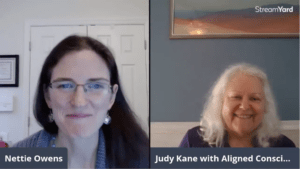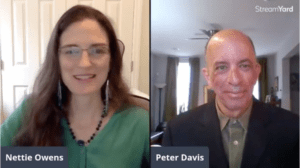What is the biggest mistake businesses are making when it comes to building their audience?
I see a lot of common mistakes.
Both small brands and solopreneurs and large brands have this one trap that they can fall into more often than any other mistake. I see that they lose track of their audience insights.
Now, insight is one of these terms that people just kind of toss around. But when I say insights, I’m talking about something that’s below the surface.
You’ve got some different things that you can learn about your audience.
You can learn data points, and that’s the clicks that open on your list or the people that visit your website. You can learn different behavior from metrics and data. But the data is only going to tell you where to dig for these insights, and insights are well below the surface.
Where I see the biggest mistake is that people don’t dig far enough to get truly vulnerable insights. Or they just assume that they hit it once, and then it’s there forever. Whereas I mean, it’s not like anything changed in 2020.
But you have to keep up to date. Because sometimes, these insights that we’re identifying can be very ephemeral. They change over time.
“How deep are you digging when it comes to insights? Are you strictly at the surface level of your data, or have you done a deep dive into what’s really going on?”
What’s something where you might see a particular data point, think that you understand it, but need to dig a little deeper?
I have a great story from the baby shampoo that probably everyone’s seen.
But back in the day, they found a really interesting data point, which was that a significant percentage of their usage volume, not purchase volume, but usage volume was actually coming from men.
They were like, “Well, that’s strange. Why are these men using this baby shampoo?” And so, they started asking questions – they started asking why.
Below that data point, which was basically just an artifact of this behavior, they did get to a deeper level of insight – that kind of raw nerve, that kind of reason behind that behavior showing up in their data – that these men who were using the baby shampoo were terrified of losing their hair. And they figured it out, and they made their own personal connection.
So, while they never put anything like this in their marketing communications, they made the connections in their head.
The connection was that if I’m terrified of losing my hair, I don’t want to anger those hair follicles, and I’m going to use the most gentle thing. And if this shampoo is so gentle as not to make the baby’s eyes tear, then that’s what I’m going to use.
And that’s the insight. The insight is something that if you feed it back to your target audience, you’re going to get a reaction. It’s going to be that raw nerve. It’s going to be the most compelling, powerful thing that you can tap into to change behavior.
“I recently was talking to someone and had them say, “You know, the people who are unengaging from your list – who are opting out from your list – are actually people who are engaged, but they’ve read enough to figure out that this isn’t the content they want to receive.”
“So often, we throw away that information as, “Oh, they don’t want to interact with me anymore.” But that insight really just flipped it on its head for me. And I thought, “Oh, okay. So, if they’re opting out, it means that I’m not connecting in some sort of way. But they wanted to connect with me at some point, and they are providing feedback and information.” So, there are insights coming at us at all times.”
“Have you tried digging a little bit deeper to find out what the behavior is that’s driving the action?”
How can businesses avoid getting “dropped” considering 75% of consumers have changed brands at least once during the pandemic?
It’s a great start if you’re trying to get new people into your world, but it’s a bad statistic if you’re trying to maintain that loyalty.
I think the key is to figure out how your current buyers lineup in three buckets.
- What percentage of your audience is ready to ditch you? Best offer, next offer comes down the pike, right?
- What percentage are happy, but they’re not completely satisfied?
- What percentage are loyalists?
Most businesses don’t know the three buckets. And if we don’t know, we don’t know how big of a risk we’re at. So, we need to first break down our group. And then, of those groups, really understand those people that are on the verge of leaving us.
Where are the biggest dissatisfactions? Where are we falling short? Is it just that they’re moving on to something else, and we’re no longer a good match for them? Or has their insight changed, and we’re not providing the right content, or the right support, or the right communication at the stage of the journey that they’re at with us?
The key is to really figure out, “Okay, how does my audience break down into those groups?” And then for each of those groups, really understand where am I falling short? What do they want? Or what do they need in order to decide to purchase from me again or to become an advocate for me?
Many people forget about that loyalist group especially and forget to even ask them to refer you? Or how can they share their satisfaction or their excitement about having worked with you?
Look at your metrics to figure out your groups. If you’ve got an email list, you can start to see who hasn’t engaged at all.
You have some metrics that you’ve gotten with your business, whether you’ve got an email list, social media, YouTube channel, etc.
You can dig into the activities and data points of all those different things to try and figure out, “Who are the people that somehow they’re just not seeing what they want to see from me?
Who are the people that just aren’t very consistent in terms of engaging with me? And then who are the ones that I’m saying something to that’s resonating with them?”
And learn from that to say, “Okay, if I want to attract more people like them, what is working?” And follow that kind of trail to figure out how to focus your content creation on something that’s going to be attracting people like your highest value audience.
“You also don’t negate your highest value audience, the ones that really like what you do and want to continue working with you. We’re not always just attracting new clients. Our best sales come from repeat customers”
3 Action Steps
1. Go below the surface of the data you have available to you to find true insights.
2. Categorize your current customers into three buckets: Ready to Ditch, Happy But Not Completely Satisfied, and Loyalists.
3. Don’t discount the importance of “Loyalists” as a means of figuring out what’s working and attracting new clients.
Connect with Mary Czarnecki on LinkedIn or at Mary Czarnecki
Please comment below. I would love to hear from you.














No comments yet.